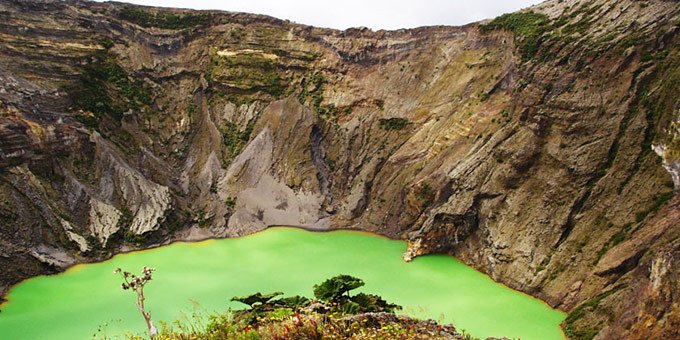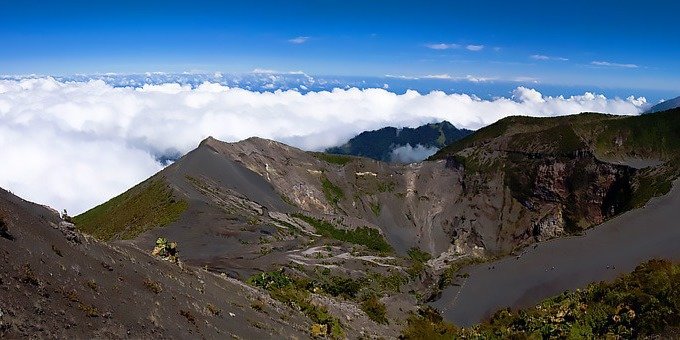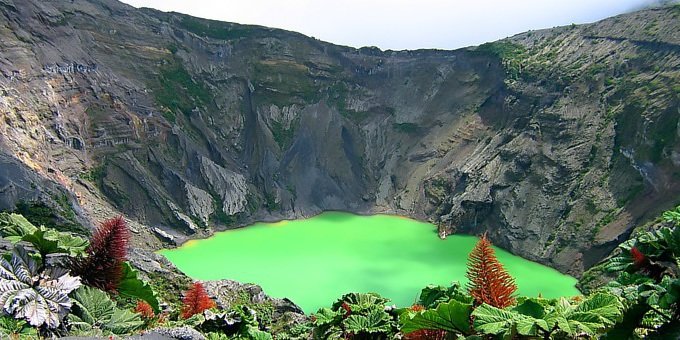
Nestled in the heart of Costa Rica's picturesque Central Valley, Irazu Volcano National Park stands as a testament to the country's fiery geological past and its lush, natural beauty. This captivating destination, encompassing approximately 5,705 acres (2,300 hectares), beckons explorers, nature enthusiasts, and adventure seekers alike. With its rugged terrain, stunning vistas, and a majestic volcano as its centerpiece, Irazu Volcano National Park promises an unforgettable journey into the heart of Costa Rica's volcanic wonderland.

A Volcanic Legacy
At the heart of this national park stands the imposing Irazu Volcano, the tallest active volcano in Costa Rica. Rising to a formidable elevation of 11,260 feet (3,432 meters) above sea level, it commands attention and awe from all who venture here. Irazu, whose name is derived from an indigenous word meaning "thunderpoint," has played a significant role in the geological history of the region.
The Volcano's Legacy
Irazu has left a profound impact on the landscape, shaping the surrounding terrain with its eruptions over millennia. The most recent major eruption, which began in 1963 and lasted for more than two years, altered the landscape dramatically, leaving behind a lunar-like landscape of ash and rock. Today, remnants of this eruption serve as a hauntingly beautiful reminder of the Earth's incredible power.
Exploring the Park
Visitors to Irazu Volcano National Park have the unique opportunity to explore this volcanic wonderland through a network of well-maintained trails and viewpoints. The primary attractions within the park include:
Crater Principal (Main Crater): The park's star attraction, the Main Crater, offers a surreal vista of a stunning turquoise-green lake nestled within the volcanic caldera. This captivating expanse of water is known as "Diego de la Haya," named after a student who tragically lost his life during a visit to the volcano. The sheer beauty of the crater, juxtaposed against its volcanic surroundings, is a sight to behold.

Crater El Piroclasto (The Piroclasto Crater): This secondary crater provides an alternate perspective of the volcano's majesty. With its smaller, yet equally picturesque lake, visitors can savor the diverse landscapes created by Irazu's powerful eruptions.
Diego de la Haya Visitor Center: The park's visitor center offers an informative introduction to the volcano's history, geology, and the diverse flora and fauna found within its boundaries. It's an excellent starting point for those eager to delve deeper into the park's mysteries.
Hiking Trails: A network of trails allows visitors to explore the park's diverse ecosystems, from cloud forests to paramo landscapes. The "Sendero Los Cartagos" trail is particularly popular, leading hikers through enchanting forests and offering panoramic vistas of the surrounding valleys.
Flora and Fauna
Despite its harsh volcanic terrain, Irazu Volcano National Park teems with life. The park's varying altitudes create diverse microclimates, fostering a wide range of flora and fauna. Hikers may encounter resplendent quetzals, coyotes, rabbits, and numerous bird species as they traverse the trails. The park's forests are adorned with mosses, lichens, and the striking "cartago" tree, which thrives in the volcanic soil.
Climate and Weather
Irazu Volcano's high-altitude location means that weather conditions can change rapidly. Visitors should be prepared for cooler temperatures and potential rain, so it's advisable to bring layers of clothing and rain gear when exploring the park.
Getting There
The park is conveniently located within a few hours' drive from the capital, San Jose. Accessible by well-maintained roads, it offers a fantastic day-trip option for those exploring Costa Rica's Central Valley.
Preservation and Conservation
Irazu Volcano National Park is not only a haven for natural beauty but also a testament to Costa Rica's commitment to conservation. The protection of this ecological gem ensures that future generations can continue to explore and marvel at the volcanic wonders that define this captivating corner of the country.
A Journey into Costa Rica's Geological Heart
Irazu Volcano National Park is a captivating destination that encapsulates the geological and natural wonders of Costa Rica. With its awe-inspiring volcano, breathtaking vistas, and diverse ecosystems, it invites visitors to embark on a journey into the heart of this volcanic paradise. Whether you're an adventure seeker, a nature enthusiast, or simply a traveler in search of Costa Rica's scenic treasures, Irazu Volcano National Park offers an unforgettable experience that will leave you with lasting memories of this remarkable country.

Services, Facilities, Price
There are hiking trails in Irazu Volcano National Park through oak and pine forests with nice picnic areas. Admission is $15 USD for non-residents and $5 for children ages 2 - 12 years old. The park is open daily from 8 to 3:30 p.m.
Craters Sector
When you venture into the Craters Sector of Irazu Volcano National Park, you'll find a range of amenities designed to enhance your visit. These include ample parking facilities, a cozy cafeteria where you can refuel, and well-maintained restrooms, thoughtfully designed to accommodate visitors with physical disabilities. As you journey along the route to the park's main attractions, you'll encounter an informative booth providing valuable insights into the park's geological wonders. Additionally, three inviting ranches offer picturesque spots for a delightful lunch amidst the natural beauty that surrounds you.
Prusia Sector
Prusia Sector of the park beckons with a myriad of trails, each offering its unique charm and natural wonders. Whether you choose to explore the El Roble, Micaela, La Cave, Chiverrales, Cabeza de Vaca, El Ahorcado, El Puma, or Los Abuelos trails, you're in for an adventure amidst lush landscapes. After a rewarding hike, take a moment to relax at the well-appointed picnic areas, providing the perfect setting for a leisurely break. Conveniently located restrooms and a supply of fresh water ensure your comfort during your exploration of this captivating sector of Irazu Volcano National Park.
To reach Irazu Volcano National Park from San Jose, you can follow these directions:
Remember to check the park's hours of operation and any special requirements before you go, as they may vary. It's also a good idea to check the weather forecast, as conditions at the summit can change rapidly.
Located in the cloud forest, the weather is fairly predictable. Expect cool and damp conditions and dress for rain. Daytime temperatures average in the low 70s with night time lows averaging in the upper 50s. The most consistent rain is experienced between the months of May through November with the heaviest rains September through November.
Visitors should pack shorts, tee shirts, appropriate shoes, rain gear, sun block. It is also advised to bring at least one pair of pants, a long sleeve shirt, and even a sweat shirt or light jacket. Check our packing list article for more ideas.
Fun Fact: Temperatures towards the summit of Irazu Volcano have been known to drop below freezing.
| Turrialba | 59 km |
| Heredia-Poas | 63 km |
| Alajuela | 72 km |
| San Jose | 86 km |
| Grecia | 96 km |
Latitude: N 9° 59' 6.72"
Longitude: W 83° 51' 41.76"
Unsure of what to do? Let us make you a free custom trip plan!